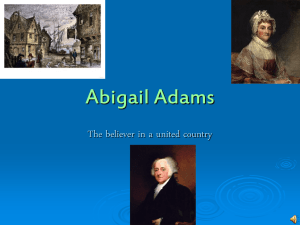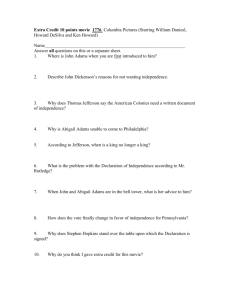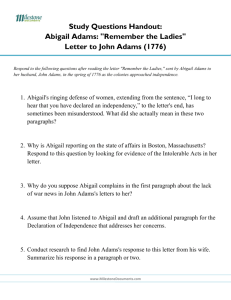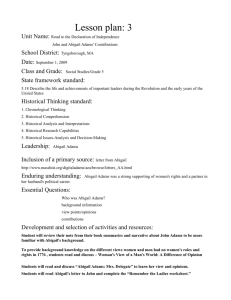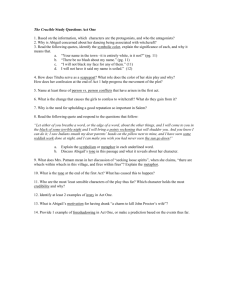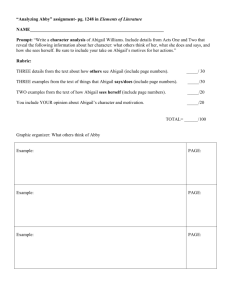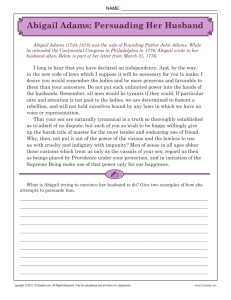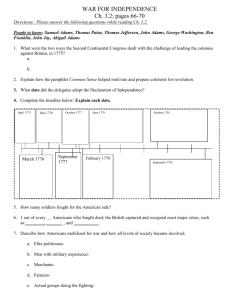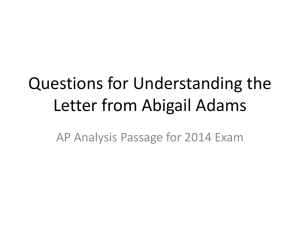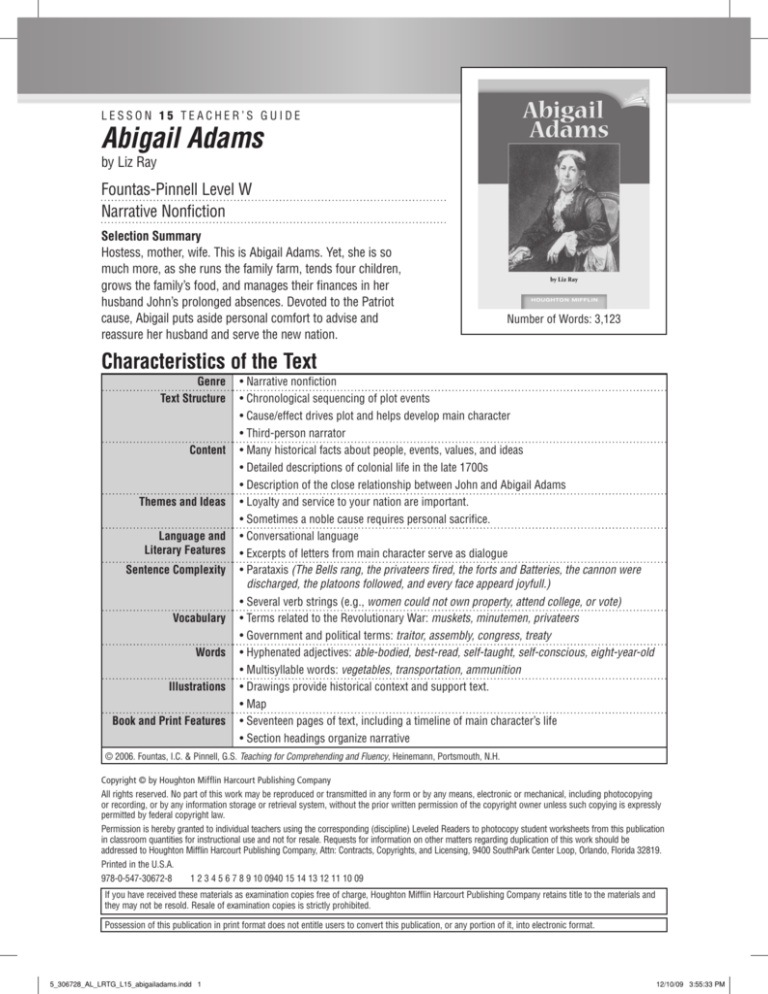
LESSON 15 TEACHER’S GUIDE
Abigail Adams
by Liz Ray
Fountas-Pinnell Level W
Narrative Nonfiction
Selection Summary
Hostess, mother, wife. This is Abigail Adams. Yet, she is so
much more, as she runs the family farm, tends four children,
grows the family’s food, and manages their finances in her
husband John’s prolonged absences. Devoted to the Patriot
cause, Abigail puts aside personal comfort to advise and
reassure her husband and serve the new nation.
Number of Words: 3,123
Characteristics of the Text
Genre
Text Structure
Content
Themes and Ideas
Language and
Literary Features
Sentence Complexity
Vocabulary
Words
Illustrations
Book and Print Features
• Narrative nonfiction
• Chronological sequencing of plot events
• Cause/effect drives plot and helps develop main character
• Third-person narrator
• Many historical facts about people, events, values, and ideas
• Detailed descriptions of colonial life in the late 1700s
• Description of the close relationship between John and Abigail Adams
• Loyalty and service to your nation are important.
• Sometimes a noble cause requires personal sacrifice.
• Conversational language
• Excerpts of letters from main character serve as dialogue
• Parataxis (The Bells rang, the privateers fired, the forts and Batteries, the cannon were
discharged, the platoons followed, and every face appeard joyfull.)
• Several verb strings (e.g., women could not own property, attend college, or vote)
• Terms related to the Revolutionary War: muskets, minutemen, privateers
• Government and political terms: traitor, assembly, congress, treaty
• Hyphenated adjectives: able-bodied, best-read, self-taught, self-conscious, eight-year-old
• Multisyllable words: vegetables, transportation, ammunition
• Drawings provide historical context and support text.
• Map
• Seventeen pages of text, including a timeline of main character’s life
• Section headings organize narrative
© 2006. Fountas, I.C. & Pinnell, G.S. Teaching for Comprehending and Fluency, Heinemann, Portsmouth, N.H.
Copyright © by Houghton Mifflin Harcourt Publishing Company
All rights reserved. No part of this work may be reproduced or transmitted in any form or by any means, electronic or mechanical, including photocopying
or recording, or by any information storage or retrieval system, without the prior written permission of the copyright owner unless such copying is expressly
permitted by federal copyright law.
Permission is hereby granted to individual teachers using the corresponding (discipline) Leveled Readers to photocopy student worksheets from this publication
in classroom quantities for instructional use and not for resale. Requests for information on other matters regarding duplication of this work should be
addressed to Houghton Mifflin Harcourt Publishing Company, Attn: Contracts, Copyrights, and Licensing, 9400 SouthPark Center Loop, Orlando, Florida 32819.
Printed in the U.S.A.
978-0-547-30672-8
1 2 3 4 5 6 7 8 9 10 0940 15 14 13 12 11 10 09
If you have received these materials as examination copies free of charge, Houghton Mifflin Harcourt Publishing Company retains title to the materials and
they may not be resold. Resale of examination copies is strictly prohibited.
Possession of this publication in print format does not entitle users to convert this publication, or any portion of it, into electronic format.
5_306728_AL_LRTG_L15_abigailadams.indd 1
12/10/09 3:55:33 PM
Abigail Adams
by Liz Ray
Build Background
Help students use their experience with self-sacrifice to visualize the selection.
Build interest by asking a question such as: When have you put someone else’s needs
before your own? Why did you do it? How did you feel about what you did? Read the title,
author, and illustrator, and talk about the cover illustration. Tell students that this book is
narrative nonfiction, and ask them what kind of features they can expect to find.
Introduce the Text
Guide students through the text, noting important ideas and helping with unfamiliar
language and vocabulary so they can read the text successfully. Here are some
suggestions:
Page 3: Ask students to define the word massacre. Explain that, in the Boston
Massacre, British soldiers killed five American colonists after the crowd had
mocked a soldier and thrown stones.
Suggested language: Would you have called this a massacre? Why or why
not? Look at the illustration. Read the caption: John Adams was the lawyer who
defended the British soldiers when they went on trial for the Boston Massacre.
Although he wanted American independence, he believed that everyone had the
right to a fair trial. Ask: What can you conclude about John Adams?
Pages 5–6: Explain that, as one of the legislators in the new Continental Congress,
John Adams spent most of his time in Philadelphia, 300 miles away from the
family farm. This created many difficulties for Abigail.
Page 14: Have students read the excerpt from Abigail’s letter. Explain why Abigail’s
capitalization and spelling is unusual. Read the second sentence in paragraph 2:
John did not agree that women should have the same freedoms as men and told
her so in his reply.
Now, go back to the beginning to learn more about Abigail Adams’s life as a Patriot
and future First Lady of the United States.
Expand Your Vocabulary
assembly – a group of persons
gathered together to make
laws, p. 4
emancipating – freeing from
bondage, oppression, or
restraint, p. 14
congress – the national legislative
body of a nation, p. 5
foment – to promote the growth
of or incite, p. 14
legislators – persons who create
or enact laws, p. 4
negotiate – to confer with one
or more persons to reach an
agreement, p. 17
patriotism – love of and devotion
to one’s country, p. 11
Grade 5
2
Lesson 15: Abigail Adams
© Houghton Mifflin Harcourt Publishing Company
5_306728_AL_LRTG_L015_abigailadams.indd 2
7/28/09 6:23:46 PM
Read
Have students read silently while you listen to individual students read aloud. Support their
understanding of the text as needed.
Remind students to use the Monitor/Clarify Strategy
important details about the setting, characters, and plot.
and to look for
Discuss and Revisit the Text
Personal Response
Invite students to share their personal responses to the selection.
Suggested language: How do you think Abigail Adams felt about all the extra work
she had to do while her husband was away? Do you think her experiences made her a
stronger person? Why or why not?
Ways of Thinking
As you discuss the text, help students understand these points:
Thinking Within the Text
Thinking Beyond the Text
Thinking About the Text
• During the American Revolution,
Abigail does her work as well as
her husband’s.
• Personal needs and wishes
sometimes aren’t as important
as the needs and wishes of a
group.
• The time setting of the selection
extends from 1770 to 1818.
• Abigail and John Adams
exchange letters to stay in
contact.
• When John Adams is elected
president, Abigail moves with
him to a partly-finished White
House.
• Sometimes people must fight for
their principles.
• Husbands and wives are partners
who work together to solve
problems and discuss issues.
• Because the characters lived
during the American Revolution,
the author includes many details
about the war and the time
period.
• The author includes details about
Abigail Adams’s many sacrifices
to show readers that she was a
strong, patriotic woman.
© 2006. Fountas, I.C. & Pinnell, G.S. Teaching for Comprehending and Fluency, Heinemann, Portsmouth, N.H.
Choices for Further Support
• Fluency Invite students to create a script for a readers’ theater based on the
description on page 10 of the way Abigail wrote to John to inform him of the
difficulties she was facing. Have students use the quote in the first paragraph on page
10 as a starting point from which to create dialogue in which John and Abigail discuss
the problems of running the family farm and how to solve those problems.
• Comprehension Based on your observations of the students’ reading and discussion,
revisit parts of the text to clarify or extend comprehension. Remind students to go
back to the text to support their ideas.
• Phonics/Word Work Provide practice as needed with words and word parts, using
examples from the text. Remind students that many English words have Latin roots
and affixes. For example, the word emancipating on page 14 comes from the Latin
root word emancipare, which means “to sell, transfer.” Other words that share this
root include emancipation and emancipate.
Grade 5
3
Lesson 15: Abigail Adams
© Houghton Mifflin Harcourt Publishing Company
5_306728_AL_LRTG_L015_abigailadams.indd 3
11/4/09 10:25:21 AM
Writing about Reading
Critical Thinking
Have students complete the Critical Thinking questions on BLM 15.9.
Responding
Have students complete the activities at the back of the book, using their Reader’s
Notebook. Use the instruction below as needed to reinforce or extend understanding
of the comprehension skill.
Target Comprehension Skill
Compare and Contrast
Remind students that readers compare and
contrast to find similarities and differences. Often, readers compare and contrast to
better understand characters, events, and setting. Model how to add details to the
Graphic Organizer, using a “Think Aloud” like the one below:
Think Aloud
The diagram states that both John and Abigail Adams believed the
colonies should be free. Abigail believed that women should have more
freedoms and opportunities. Write that in the left oval. John Adams
disagreed with his wife’s views on women’s rights. Put that in the righthand oval. In this way, Abigail and John Adams’s efforts and beliefs have
been compared and contrasted.
Practice the Skill
Encourage students to share an example of a selection in which characters’ beliefs can be
compared and contrasted.
Writing Prompt: Thinking Beyond the Text
Have students write a response to the writing prompt on page 6. Remind them that
when they think beyond the text, they use their personal knowledge to reach new
understandings.
Assessment Prompts
• Abigail Adams read the books in her father’s library to show that
________________________________________________________________.
• Which sentences from the selection show that John Adams is a loving husband?
• What can the reader conclude about the American Revolution as described in this
selection?
Grade 5
4
Lesson 15: Abigail Adams
© Houghton Mifflin Harcourt Publishing Company
5_306728_AL_LRTG_L015_abigailadams.indd 4
11/4/09 10:25:29 AM
English Language Development
Reading Support Have students listen to the audio or online recordings. Make sure
the text matches the students’ reading level. Language and content should be accessible
with regular teaching support.
Idioms The text includes some American idioms, such as thirst for knowledge (page
4), burst into tears (page 5), and spoken her mind (page 15). Explain that the author uses
modern idioms in a selection about the eighteenth century because they communicate to
today’s American readers.
Oral Language Development
Check student comprehension, using a dialogue that best matches your students’
English proficiency. Speaker 1 is the teacher, Speaker 2 is the student.
Beginning/Early Intermediate
Intermediate
Early Advanced/ Advanced
Speaker 1: Who is the main character?
Speaker 1: Why is John Adams away
from home so much?
Speaker 1: Why does John Adams
offer to resign?
Speaker 2: John Adams was elected
to the Continental Congress in
Philadelphia.
Speaker 2: John Adams knows that
Abigail’s life has been difficult with
him gone. He doesn’t want her to
suffer.
Speaker 2: Abigail Adams
Speaker 1: In what time and place is
the selection set?
Speaker 2: Boston, Massachusetts in
the late 1700s
Speaker 1: Who is Abigail Adams’s
husband?
Speaker 2: John Adams
Speaker 1: How does Abigail’s life
change because John is gone?
Speaker 1: Why does Abigail Adams
tell her husband not to resign?
Speaker 2: Abigail must now do her
work and John’s work.
Speaker 2: Abigail Adams is a patriot
and feels that the country’s needs
come before hers.
Lesson 15
Name
Date
BLACKLINE MASTER 15.9
Critical Thinking
Abigail Adams
Critical Thinking
Read and answer the questions. Possible responses shown.
1. Think within the text What were women and enslaved people not
allowed to do in the 1700s?
They could not own property, attend college, or vote.
2. Think within the text What jobs did women have in the
household?
cleaning, sewing, raising crops, caring for the sick
3. Think beyond the text Compare and contrast Abigail Adams’s life
before and after her husband became involved in the Patriot cause.
Before, the family lived in Boston. After, they moved to their farm
and Abigail had to take care of the farm and their four children by
herself when John was away.
4. Think about the text Do you think that the author considered
Abigail Adams a hero? Why or why not?
Yes, because she was one of the first people to fight for the rights
of women.
Making Connections Abigail Adams did many kind things for others. Write
about a kind act you have done for someone. Discuss how the person may
have felt about what you did.
Write your answer in your Reader’s Notebook.
Critical Thinking
11
Grade 5, Unit 3: Revolution!
© Houghton Mifflin Harcourt Publishing Company. All rights reserved.
11_5_246253RTXEAN_L15.indd 11
Grade 5
5
3/23/09 10:57:52 AM
Lesson 15: Abigail Adams
© Houghton Mifflin Harcourt Publishing Company
5_306728_AL_LRTG_L15_abigailadams.indd 5
12/16/09 1:22:17 PM
Name
Date
Abigail Adams
Thinking Beyond the Text
Think about the questions below. Then write your answer in two or
three paragraphs.
Remember that when you think beyond the text, you use your personal
knowledge to reach new understandings.
On page 14, Abigail Adams writes, “If perticuliar care and attention is
not paid to the Laidies we are determined to foment a Rebelion, and will
not hold ourselves bound by any Laws in which we have no voice, or
Representation.” What “attention” does Abigail want for women? Do you
think she has the right to disobey laws to achieve her goals? Why or why
not? In what ways do you feel Abigail’s goals for women have been achieved
nowadays?
Grade 5
6
Lesson 15: Abigail Adams
© Houghton Mifflin Harcourt Publishing Company
5_306728_AL_LRTG_L015_abigailadams.indd 6
7/28/09 6:23:49 PM
Lesson 15
BLACKLINE MASTER 15.9
Name
Date
Critical Thinking
Abigail Adams
Critical Thinking
Read and answer the questions.
1. Think within the text What were women and enslaved people not
allowed to do in the 1700s?
2. Think within the text What jobs did women have in the
household?
3. Think beyond the text Compare and contrast Abigail Adams’s life
before and after her husband became involved in the Patriot cause.
4. Think about the text Do you think that the author considered
Abigail Adams a hero? Why or why not?
Making Connections Abigail Adams did many kind things for others. Write
about a kind act you have done for someone. Discuss how the person may
have felt about what you did.
Write your answer in your Reader’s Notebook.
Grade 5
7
Lesson 15: Abigail Adams
© Houghton Mifflin Harcourt Publishing Company
5_306728_AL_LRTG_L015_abigailadams.indd 7
7/28/09 6:23:50 PM
Student
Lesson 15
Date
BLACKLINE MASTER 15.13
Abigail Adams • LEVEL W
page
5
Abigail Adams
Running Record Form
Selection Text
Errors
Self-Corrections
Accuracy Rate
Total SelfCorrections
Even when John was home, Abigail worked hard on the farm.
She cooked all the family’s meals in the fireplace, using heavy
iron pots and pans. She made their clothes, tended the garden,
and took care of the livestock. They had cows for milk, sheep
for wool and meat, and chickens for meat and eggs. They also
owned horses to plow the fields and for transportation. Abigail
grew all the vegetables, including onions, potatoes, and
pumpkins, that they would eat during the winter when the
garden was covered with snow. Abigail also took care of their
four children, teaching them to do chores, read, and behave
properly.
Comments:
(# words read
correctly/107 ×
100)
%
Read word correctly
Code
✓
cat
Repeated word,
sentence, or phrase
®
Omission
—
cat
cat
Grade 5
Behavior
Error
0
0
Substitution
Code
cut
cat
1
Self-corrects
cut sc
cat
0
Insertion
the
1
cat
Error
1414079
Behavior
ˆ
Word told
1
8
T
cat
1
Lesson 15: Abigail Adams
© Houghton Mifflin Harcourt Publishing Company
5_306728_AL_LRTG_L015_abigailadams.indd 8
7/28/09 6:23:51 PM

